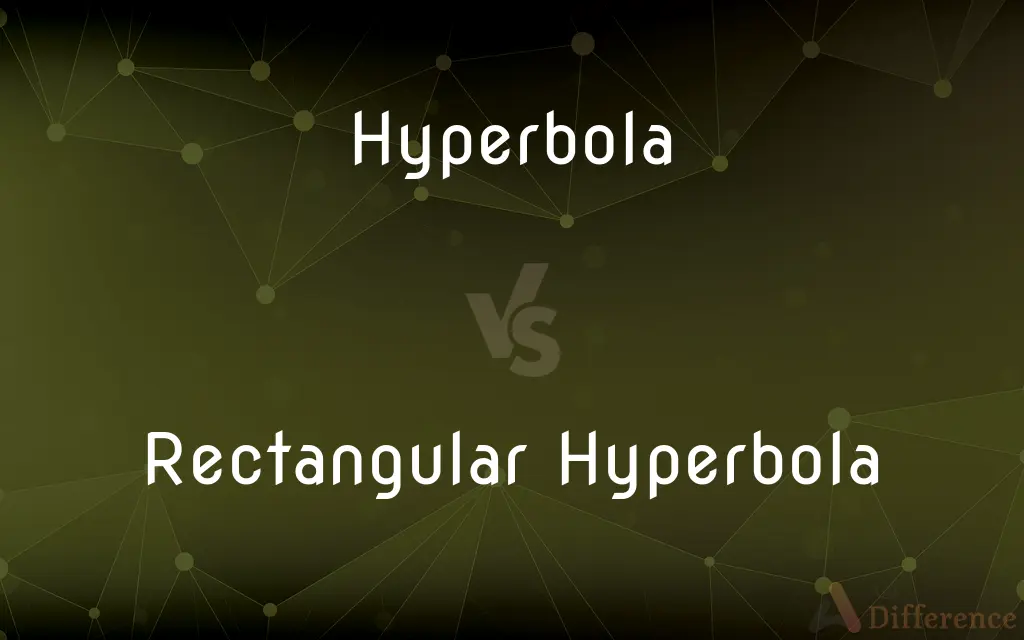Hyperbola vs. Rectangular Hyperbola — What's the Difference?
By Maham Liaqat & Urooj Arif — Published on February 21, 2024
A hyperbola is a type of conic section with two symmetrical open curves, while a rectangular hyperbola is a specific hyperbola where the asymptotes are perpendicular, forming a rectangle in the asymptote intersections.

Difference Between Hyperbola and Rectangular Hyperbola
Table of Contents
ADVERTISEMENT
Key Differences
A hyperbola is defined by its two mirror-image branches, each approaching a pair of lines called asymptotes, without ever touching them. This shape is the result of slicing a double cone with a plane at a steeper angle than the cone's sides, and it can vary widely in the angles between its asymptotes, determining the hyperbola's "openness."
A rectangular hyperbola, on the other hand, is a special case where the asymptotes intersect at right angles. This property means that the axes of the hyperbola are of equal length, making the shape symmetrical around both its axes.
The distinction lies in the asymptotes' orientation: while all hyperbolas have asymptotes that define their open curves, only in rectangular hyperbolas are these asymptotes perpendicular to each other. This specific structure of rectangular hyperbolas gives them unique properties, such as the product of the coordinates of any point on the hyperbola being constant.
In various scientific fields, rectangular hyperbolas are particularly significant. For instance, in physics, they can represent the relationship between variables that are inversely proportional, like pressure and volume in Boyle's law under constant temperature. Understanding the difference between general hyperbolas and the particular case of rectangular hyperbolas is crucial for correctly applying these concepts in both mathematical and real-world contexts.
Comparison Chart
XDefinition
A conic section with two open, mirror-image branches
A hyperbola with asymptotes that intersect at right angles
ADVERTISEMENT
Asymptotes
Can have various angles of intersection
Always intersect at a 90-degree angle
Axes Lengths
Can have different lengths for its transverse and conjugate axes
Axes are of equal length, giving it a square symmetry
Applications
Broad, from orbital paths to radio wave propagation
Often used to represent inverse relationships, like in Boyle's law
Compare with Definitions
Hyperbola
Has two branches that extend to infinity without converging.
In radar systems, hyperbolic shapes model the paths of signals between antennas.
Rectangular Hyperbola
Represents inverse proportional relationships in physics.
Boyle's law, PV = constant, can be graphed as a rectangular hyperbola.
Hyperbola
Used to describe certain types of optical paths and reflections.
Light reflection in a hyperbolic mirror focuses along a hyperbolic path.
Rectangular Hyperbola
A hyperbola with perpendicular asymptotes, creating a rectangular symmetry.
The curve xy = 4 is a rectangular hyperbola with axes along the coordinate lines.
Hyperbola
Can represent hyperbolic functions in mathematics.
The graph of cosh(x) and sinh(x) depicts a hyperbola's right branch.
Rectangular Hyperbola
Used in economics to illustrate certain types of trade-offs.
Indifference curves in microeconomics can sometimes form rectangular hyperbolas.
Common Curiosities
Why are rectangular hyperbolas important in economics?
They are used to model relationships where two variables are inversely related, such as utility functions where two goods are perfect substitutes.
Are all hyperbolas symmetric?
Yes, all hyperbolas have two symmetrical branches, but the symmetry in rectangular hyperbolas is specifically around both the x and y axes due to their perpendicular asymptotes.
What is the significance of the constant product in a rectangular hyperbola?
The constant product of coordinates for any point on a rectangular hyperbola signifies the conservation of a product, like energy or momentum, in physical systems.
Are the applications of rectangular hyperbolas limited to specific fields?
While particularly useful in physics and economics, rectangular hyperbolas' utility extends to any domain requiring modeling of inversely proportional relationships or phenomena with constant product properties.
Do rectangular hyperbolas appear in nature or science?
Yes, they can describe natural phenomena where two variables are inversely proportional, like pressure and volume in an ideal gas at constant temperature.
Can the focus points of a rectangular hyperbola be found like any hyperbola?
Yes, the foci of a rectangular hyperbola can be calculated using its standard properties, though their positions are uniquely determined by the hyperbola's square symmetry.
Can any hyperbola be considered rectangular?
No, only those with asymptotes at right angles to each other are classified as rectangular hyperbolas.
How do the asymptotes affect a hyperbola's shape?
The asymptotes guide the branches of a hyperbola, determining their openness and direction, with the rectangular hyperbola having a more defined square shape due to its perpendicular asymptotes.
What differentiates a hyperbola in standard position from a rectangular hyperbola?
A standard hyperbola has its center at the origin and its axes along the coordinate axes, while a rectangular hyperbola also meets these criteria but has the additional property of perpendicular asymptotes.
How does the eccentricity of a rectangular hyperbola compare to that of a general hyperbola?
All hyperbolas, including rectangular ones, have an eccentricity greater than one, but the eccentricity itself doesn't determine whether a hyperbola is rectangular. The rectangular nature is defined by the perpendicular asymptotes rather than eccentricity values.
Can rectangular hyperbolas be used to describe orbits in space?
While elliptical orbits are more common for celestial bodies, rectangular hyperbolas could theoretically describe certain unbound trajectories, such as a high-speed comet passing through the solar system, though these would be rare and idealized cases.
How do you transform a general hyperbola into a rectangular one?
Transforming a general hyperbola into a rectangular one involves rotating the coordinate system or the hyperbola itself by an appropriate angle so that the asymptotes become perpendicular. This typically requires applying a rotation matrix or coordinate transformation in the equation of the hyperbola.
Share Your Discovery

Previous Comparison
Statue of Liberty vs. Statue of Unity
Next Comparison
Nitro vs. Nitro ClassicAuthor Spotlight
Written by
Maham LiaqatCo-written by
Urooj ArifUrooj is a skilled content writer at Ask Difference, known for her exceptional ability to simplify complex topics into engaging and informative content. With a passion for research and a flair for clear, concise writing, she consistently delivers articles that resonate with our diverse audience.
















































